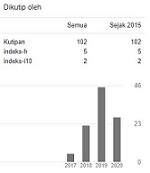THE STUDENTS’ NERVOUSNESS MODEL IN TEACHING LEARNING PROCESS
Abstract
Keywords
References
Asif, F. (2017). The Anxiety Factors among
Saudi EFL Learners: A Study from
English Language Teachers’ Perspective. English Language
Teaching, 10(6), 160.
https://doi.org/10.5539/elt.v10n6p16
Aydin, S., Akkaş, F. D., Türnük, T.,
Beydilli, A. B., & Saydam, I. (2020).
Test anxiety among foreign language
learners: A qualitative study.
Qualitative Report, 25(12), 4289–
https://doi.org/10.46743/2160-
/2020.4686
Ekalestari, S., & Pasaribu, A. (2017). The
Anxiety of Learning English by Senior
High School Students in Medan. 2008,
–721.
Hashemi, M. (2011). Language stress and
anxiety among the English language
learners. Procedia - Social and
Behavioral Sciences, 30, 1811–1816.
https://doi.org/10.1016/j.sbspro.2011.
349
Jafarigohar, M., & Behrooznia, S. (2012).
The effect of anxiety on reading
comprehension among distance EFL
learners. International Education
Studies, 5(2), 159–174.
https://doi.org/10.5539/ies.v5n2p159
Kasbi, S., & Elahi Shirvan, M. (2017).
Ecological understanding of foreign
language speaking anxiety: emerging
patterns and dynamic systems. AsianPacific Journal of Second and Foreign
Language Education, 2(1).
https://doi.org/10.1186/s40862-017-
-y
Khattak, Z. I., Jamshed, T., Ahmad, A., &
Baig, M. N. (2011). An investigation
into the causes of English language
learning anxiety in students at
AWKUM. Procedia - Social and
Behavioral Sciences, 15, 1600–1604.
https://doi.org/10.1016/j.sbspro.2011.
337
Male, H. (2018). Foreign Language
Learners’ Anxiety in Language Skills
Learning: A Case study at Universitas
Kristen Indonesia. JET (Journal of
English Teaching), 4(3), 170.
https://doi.org/10.33541/jet.v4i3.854
Namaziandost, E., Hafezian, M., & Shafiee,
S. (2018). Exploring the association
among working memory, anxiety and
Iranian EFL learners’ listening
comprehension. Asian-Pacific Journal
of Second and Foreign Language
Education, 3(1).
https://doi.org/10.1186/s40862-018-
-3
Neff, P., & Neff, P. E. (2007). The Roles of
Anxiety and Motivation in Language
Learner Task Performance. Doshisha
Studies in Language and Culture,
(1), 23–42.
https://www.researchgate.net/publicati
on/253260214
Nimasari, E. P. (2018). The Asian EFL
Journal. Asian EFL Journal, 20(4),
Owen, E. A., & Razali, A. B. (2018). The
effect of communicative activities on
Libyan secondary school students’
speaking performance in Malaysia.
International Journal of Instruction,
(4), 45–60.
https://doi.org/10.12973/iji.2018.1144
a
Sawaludin, Pammu, A., & Sahib, H. (2021).
The Effects of Anxiety toward
Listening Comprehension at
University Level. International
Journal of Innovative Science and
Research Technology, 6(1).
Yurtseven, N., & Akpur, U. (2018).
Perfectionism, Anxiety and
Procrastination as Predictors of EFL
Academic Achievement: A Mixed
Methods Study. Novitas-ROYAL
(Research on Youth and Language),
(2), 96–115
DOI: 10.53712/ellite.v7i2.2448
Refbacks
- There are currently no refbacks.







